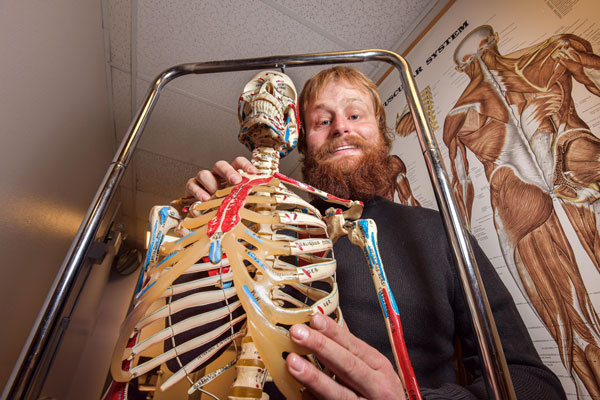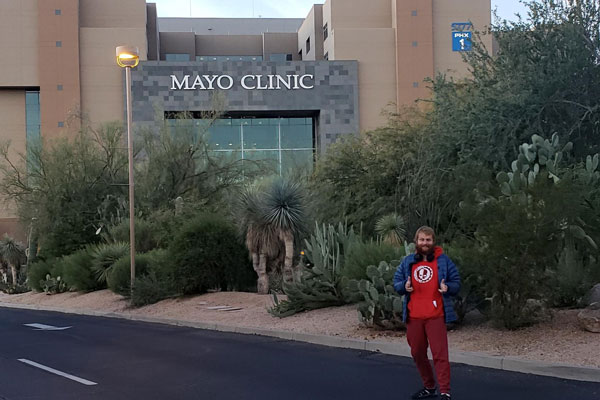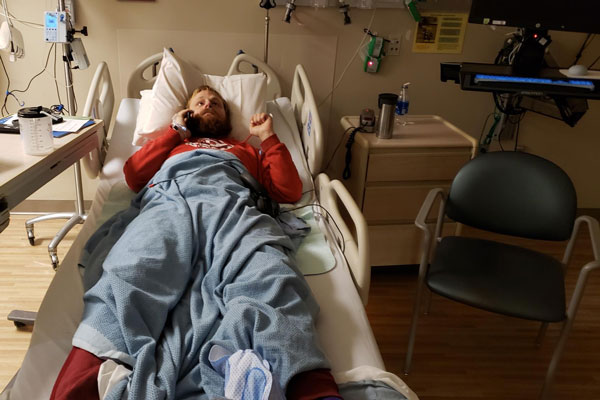How one living kidney donor saved six lives

More than half of all U.S. adults are registered to donate their organs when they’re deceased, but what if we didn’t have to wait until then to save someone’s life? We don’t. Just ask Lawrence Allen, a Sandia data engineer who made the selfless and courageous decision to become a living organ donor to help a stranger in need.
Humans are equipped with two bean-shaped kidneys on the left and right sides of the spine that are responsible for filtering out waste, making critical hormones and balancing water and salt levels. However, we don’t need both of them.
“In the back of my mind, I thought this would be a cool thing you could do. But more generally, once you realize there are people out there who have no functioning kidneys and are dying because of it, and you have two kidneys and can do with one, it’s kind of self-explanatory that you should try to give them one.”
The Organ Procurement and Transplantation Network reports that there are currently 95,000 people on the national kidney waiting list. In 2019, Lawrence became one of 355 living, anonymous donors who made that list move, joining a total of just 2,770 donors to date.
National Donor Day is Feb. 14
“People spend an average of five years on the kidney waiting list. The survival rate of dialysis for five years is about 35%,” Lawrence said. “The fact that you make the list move, the people waiting, means that everyone on the list has to wait less time, which means that aside from the people on your chain, you also help a lot of other people in a very subtle way.”
A “chain” is usually set off by a non-directed donor, like Lawrence, who donates a kidney to a recipient whose family member is willing to donate but isn’t a compatible match. In turn, that family member gives their donation to someone else waiting for a transplant. The pattern can continue for multiple recipients.
“If you do a non-directed donation at a place that does chains, your kidney donation will end up with a bunch of other people getting them. So in my case, six other people got kidneys because of it,” he said. “That’s what you want if you are going to anonymously donate a kidney.”
First link in the chain
Lawrence had tried donating multiple times before but ran into various roadblocks. After he was hired at Sandia fulltime at the start of 2019, he decided to try one last time before he and his wife had kids.

When he was ready, he turned to the Mayo Clinic in Phoenix, Arizona, to start the process, which involved filling out a form, passing an initial phone screening and spending four days in Arizona for additional testing.
Once Lawrence got approval from the Mayo Clinic to move forward with the donation, he told his manager, Tom Scripter, his plans. Tom was very helpful in figuring out how to take time off and complete the HR forms.
“My coworkers were nothing but lovely and supportive, and helped me get my projects into a state where I could take three weeks off,” Lawrence said. “No one ever questioned my right to go do this.”
Throughout the entire process, Lawrence didn’t have to use any vacation. After consulting with HR, he discovered that you can use sick time for medical testing, and many of the initial screenings could be completed at Sandia’s medical clinic.
“That’s one of the biggest ways Sandia helped. We get pretty generous vacation time, but we get lots of sick leave, and you can use sick leave for all of this. You can even get FMLA for it,” he said. “The HR department here is amazing. They were so helpful.”
Lawrence scheduled the surgery for Dec. 16, the Monday after finals and a week and a half before Sandia’s winter shutdown. After one last round of testing in early December, he and his dad went to Arizona for the procedure.
Op and post-op
The laparoscopic surgery began around 10 a.m. so that it could go to someone in Phoenix that same day. Lawrence explained that the relatively low-risk surgery takes about 2-3 hours to complete, and after recovery, the donor returns to a normal life. Aside from having to avoid a few medications, there aren’t any restrictions.

“I woke up after they were done, still on the operating table, and I’m like, ‘Where am I?’ and they said, ‘You’re in the Mayo Clinic in Phoenix. You just donated your kidney to a stranger.’ Apparently the first words out of my mouth were, ‘I did what?!’”
Lawrence spent one night in the hospital and was up and walking around the next day thanks to pain medications that he initially chose to forgo — a decision he wouldn’t recommend. He spent the following five days recuperating in a rented condo before his dad drove him back to New Mexico.
“My dad, who is a former Sandian — it was awesome what he did for me, and I would not have been able to donate without him,” Lawrence said, adding that his dad had cooked and cared for him while he recovered. “My dad and I would watch movies every night, which was nice. It was a little chance to reconnect with him.”
Lawrence said he was thankful for his mom, as well. She stayed with him for four days after he returned to Albuquerque. During his recovery, he played video games, watched movies and was even able to walk his dog. Although he tired more quickly than usual, he got slightly better each day.
Lawrence returned to work just three weeks after the surgery. A week later, he said, “I feel fine now. I ran a 5k yesterday. I’m not quite where I was, but I’m back to basically normal. It’s amazing how quickly you can bounce back from having one of your organs taken out. You would not expect it.”
Inspired to help?
Lawrence hopes to inspire others to donate. “If you’re considering what to do with your limited amount of resources and time to help people, this really should be near the top of your list if you can swing the time off, which, at Sandia, you can.” He also said that although he didn’t use them, there are foundations that can help pay for expenses and lodging related to the procedure.
“Six people got new kidneys, and all it cost me was a terrible night in the hospital and kind of a bad week in Phoenix,” he said, reflecting on the experience. “It’s not nothing because it’s three weeks off work, but I don’t think I’m an especially special person. I thought about this a fair amount while I was lying in bed, thinking about why I did this. As far as I can tell, the only thing that makes me different than people who haven’t done this is that one day, I decided to fill out the form and pursue the process.”
National Donor Day is Feb. 14. Anyone interested in becoming a living organ donor can visit the National Kidney Registry or contact Lawrence for more information.